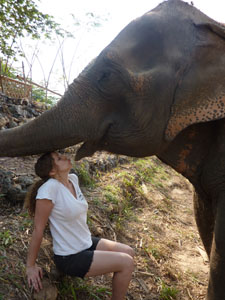Holidays, STM style
A few years ago, Adam and I made the decision that our major holiday each year would be spent volunteering at an animal sanctuary somewhere in the world. We've both done plenty of packpacking, beach holidays, and city romps in our lives, and at this point, this is what feels like the most meaningful way to spend our time. If it sounds like I'm on a high horse, you've got me wrong. This choice is not motivated by pure altruism. We both love animals, and this is how we get a chance to cuddle up to species that we wouldn't normally be able to get close to, while doing them a bit of good at the same time.
 | | Elephant Nature Park Chiang Mai, Thailand Last year, for our honeymoon, Adam and I volunteered at the Elephant Nature Park. ENP is a sanctuary to over 30 orphaned, abused, and injured elephants, most of whom have been rescued from the tourism or logging industries. Lek Chailert, founder, works tirelessly to educate the world about the terrible treatment of elephants in Thailand, and the need for intervention. She is truly an inspiration. I can't possibly say enough about what an incredible experience we had at the Elephant Nature Park, and what a truly special place it is. I would certainly urge anyone to do it. You can see some pictures here.
|
The Work: Volunteering at ENP is very well organized. You have three work shifts a day, about 1.5 hours each. You might be preparing food for the elephants (stacking watermelon, washing pumpkins, shucking corn), shoveling elephant poop, chopping down banana trees with machetes, harvesting corn (also with machetes... machetes are pretty popular there), filling bags with sand to bring to the elephant enclosures, stomping around in a mud pit, or helping to build fences. In other words, you really work, although you are only expected to do as much work as you are capable of and comfortable with.
Contact with the Animals: Although the work you do is not directly with the elephants, you get to spend plenty of time in direct contact with them. You can participate in feeding them as often as you want, you can accompany them into the river and help bathe them every day, and if you learn which elephants are friendly, you can simply spend time with them (in the presence of their mahout, or caretaker, for your assured safety). It's not unlimited access, you have to stick to the rules and play it safe, but you can certainly get as much contact as you choose.
Living: At ENP, you live in a bamboo hut with basic electricity. The huts were very clean and the beds comfortable. There are numerous shared shower rooms, also very clean. No hot water.
Food: Amazing. All three meals are served buffet-style, and there is always plenty to eat. Lunch is especially delicious, with a huge spread every day.
Cost: Currently, about $400 per person per week.
 | | Monkey Rescue Center Puyo, Ecuador This February, we decided to work with monkeys in South America. Centro Rescate de Los Monos (sometimes called Paseo Los Monos) is a sanctuary that houses about 65 monkeys of 5 different species, as well as a host of other animals including coatis, agoutis, tortoises, and talking parrots. Most of the animals here have been the victims of the animals trafficking trade. Many have been kept as pets, and cannot return to the wild. The sanctuary is set in the jungle, and most of the monkeys roam free. They always seem to come back, though, where they know they can get food and plenty of affection. We had a fantastic time at the sanctuary, and highly recommend it. Pics are here.
|
The Work: Volunteering is not as well organized here, and you don't work as hard. You will spend mornings cutting up fruits and vegetables to feel all of the animals. That is the only specifically scheduled work. Much of the rest of the time, you are there to play with the monkeys, and help give tours to daytrippers. That said, there is always other work that needs to be done, although the people who work there don't always think to ask. So it's up to you to ask, and make it known that you want to help. If you offer to clean out an enclosure, or haul out the rubbish with them, or help build a new enclosure, or wash up the kitchen, they really appreciate it and will value your contribution.
Contact with the Animals: You will have more monkey contact than you ever thought possible. Monkeys will be all over you most of the time. It's wonderful.
Living: You will live in one of two volunteer houses. All rooms are for two people. Some are bunk beds, some double beds. If they are not full up, you may have a room to yourself. Each house has a kitchen and a bathroom with shower. There is hot water in the shower.
Food: Lunch is the one meal that everyone eats together: the owners, the volunteers, and the people who work there. It is generally cooked by the owner, although sometimes a volunteer might offer to take the responsibility on for the day. It is always pretty tasty. Breakfast and dinner you cook in your house, although you take all the ingredients that you want from the main house. If there is anything you want, you just let them know, and it is bought for you by the sanctuary. Volunteers often cook and eat dinner together.
Cost: $100 per person per week.
A great source for other free and low-cost volunteer opportunities in South America is here.

